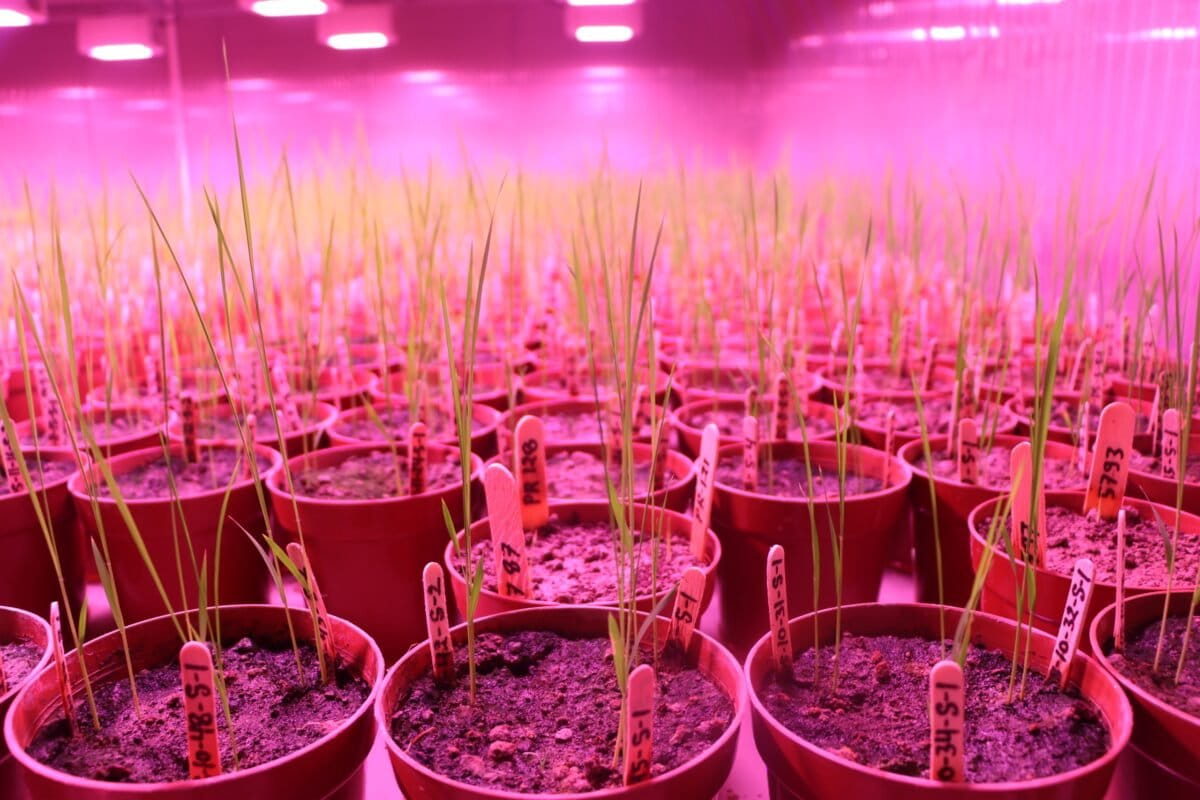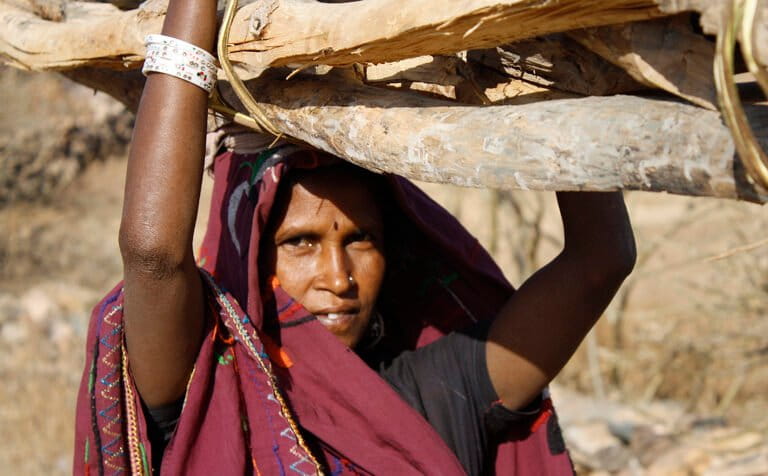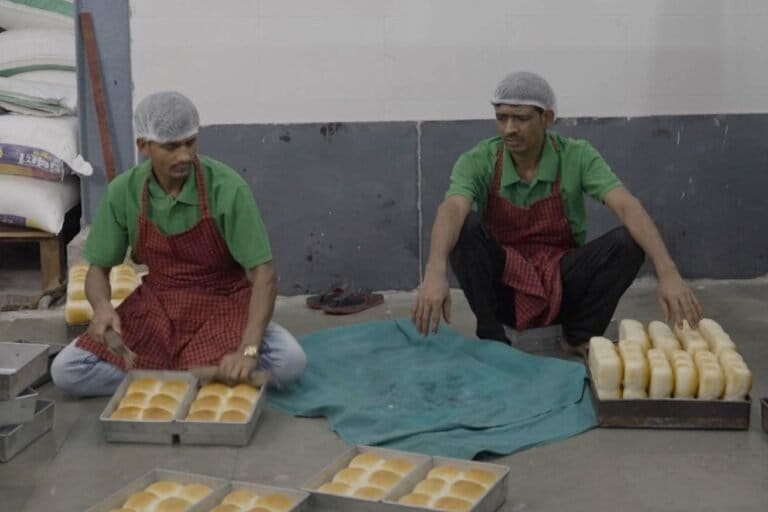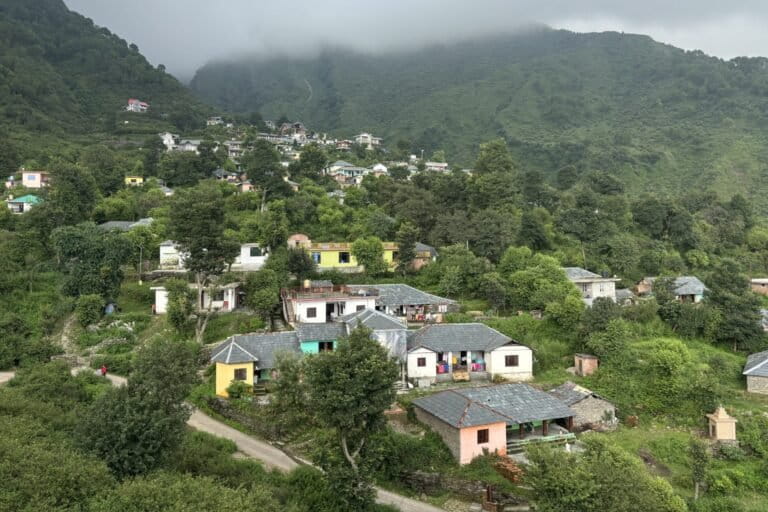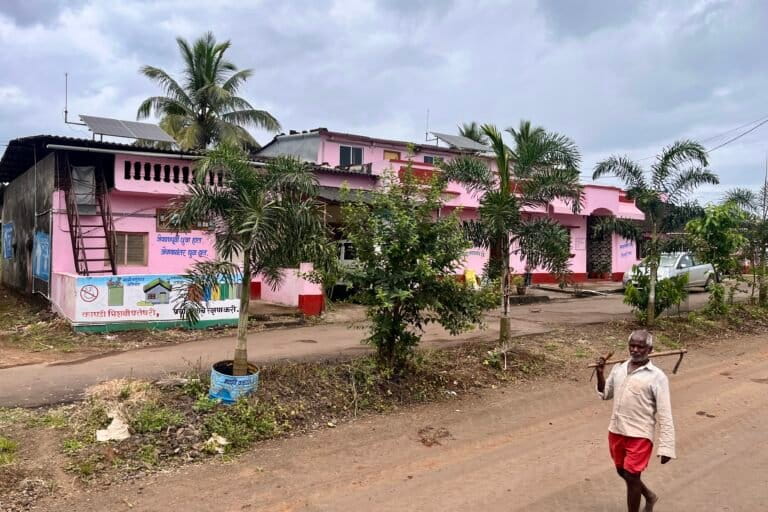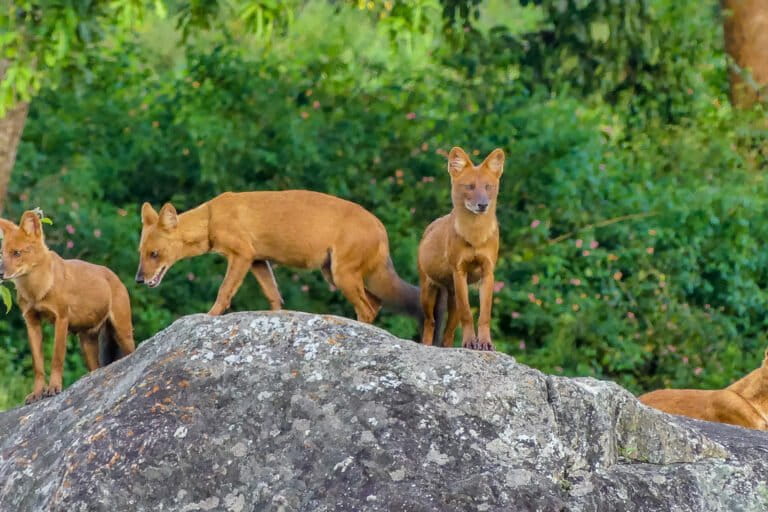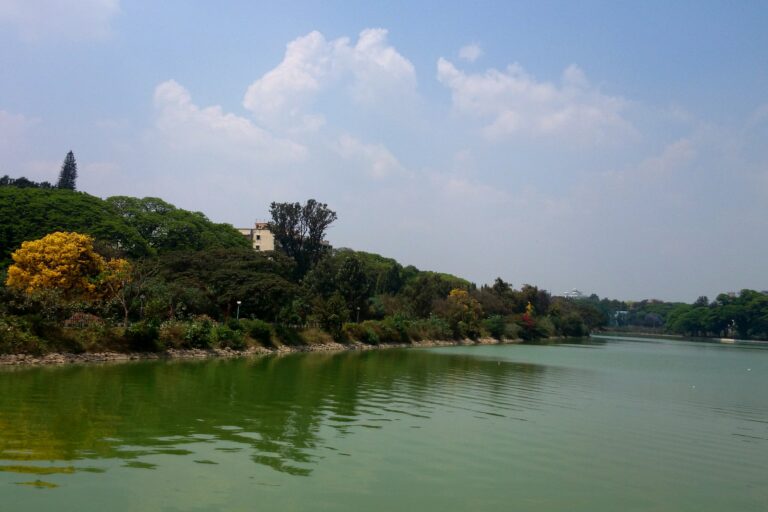- Reviving the lost tradition of millet in Madhya Pradesh is met with various challenges including the difficulty in processing and storing the grain.
- The tribal communities, for whom the grain was once a staple diet, now prefer to eat rice accessible freely through the public distribution system.
- Lack of minimum support price for millets and the government’s push for hybrid seeds for better yield are other reasons preventing traditional farmers from cultivating the grain.
In the expansive compound surrounding Sundi Bai Uike’s hut made from a mixture of clay and cow dung, in the central Indian state of Madhya Pradesh, a row of 10 oxen stands tethered to a central pole. The ground beneath them is strewn with dry stalks of kodo millet. Upon command, the oxen walk around the pole, their hooves rhythmically stamping down on the millet stalks. This pole serves as a vital component of the traditional thresher, employed by farmers like Uike, to separate millet grains from their stalks. Following the threshing process, Uike will proceed to remove the finer layers of husk from the seeds using the traditional mortar located within the courtyard of her modest home in Kevlari village in the state’s Mandla district. “We only process what we need. I will remove the husk in a chakki (a traditional stone grinder) and then grind further with a wooden pestle,” she says as she nudges the oxen forward with gentle slaps on their backs.

Traditionally consumed by indigenous communities across the country, millets like kodo (Paspalum scrobiculatum) and kutki (Panicum sumatrense) formed the staple diet of two of the seven tribal communities named Gond and Baiga in Madhya Pradesh. While the Green Revolution in India in the 1960s successfully met food sufficiency in the country, it also replaced these traditional grains with rice and wheat. Millets came to be regarded as poor man’s grains despite their nutritional value and climate resilience.
In an attempt to revive the tradition of millet consumption, the year 2023 was declared as the International Year of Millets by the United Nations following a request by the government of India.
Read more: Why is 2023 the International Year of Millets?
Millets for food and nutritional security
A report released by the Ministry of Agriculture and Farmers’ Welfare in March 2023 calls millets the “backbone of Indian agriculture” as they are hardy, resilient and climate adaptable crops that can grow easily in degraded soil and survive in temperatures up to 50 degrees Celsius. “Millets, in general, are climate resilient. They can even withstand drought-like conditions and survive in minimal moisture. As the country has large areas under rain-fed cultivation, millets are suitable for different topographies,” says Israel Oliver King, director of biodiversity at M.S. Swaminathan Research Foundation, Chennai.
While millet consumption is witnessing a gradual rise in popularity among urban Indians, the tribal communities, for whom the grain was once a staple diet, prefer to eat rice accessible freely through the public distribution system (PDS). Being low in iron and amino acids, rice does not necessarily provide adequate nutrition to a good number of tribal populations struggling with conditions like anaemia. As per National Family Health Survey-5 (NFHS-5), around 72.7% children (6 months to 5 years) and around 55.8% women (15 to 49 years), in the rural parts of MP, were found to be anaemic, showing a 3.8% and 2.2% rise in anaemia among both groups from NFHS-4.
King points out that millets are rich in fibre, minerals like calcium and iron and are a good source of amino acids that are vital for nutrition. Each millet has its own nutrient profile that adds value to our food system.

To provide nutritional security, the Women and Child Welfare Department is now promoting the use of millets in various forms, including hot-cooked meals and take-home rations at Anganwadis (rural child care centre) for pregnant women, lactating mothers and their children under the age of six, as part of the Poshan Abhiyan 2.0, a government scheme focussed on diet diversity, food fortification and popularising use of millets. “Millets are known to have high nutrient content which includes protein, essential fatty acids, dietary fibre, B-vitamins, minerals such as calcium, iron, zinc, folic acid and other micro-nutrients thus helping to tackle anaemia and other micronutrient deficiencies common among women and children,” according to a statement from the department issued last year.
Despite indigenous communities making up over one-fifth of the population in Madhya Pradesh, the state ranks only fifth in the production of millets with 1,276 thousand tonnes in 2022-23, after Rajasthan, Uttar Pradesh, Karnataka and Maharashtra, indicating a slow shift back to the conventional diet.
Challenges in mainstreaming millets
Numerous practical challenges hinder the integration of millet into mainstream markets. The majority of farmers cultivating millets rely on traditional cultivation methods, which are not conducive to large-scale production. Following each harvest, fields must be left fallow to allow the soil to replenish its nutrients before millets can be planted again, dissuading many from continuing millet cultivation. Consequently, despite its status as a water-inefficient crop, farmers often opt to cultivate paddy instead.
“We are encouraging farmers to adopt new farming techniques such as line-sowing and organic fertilisers to enhance yield, enabling them to sustain millet cultivation without incurring losses,” explains Yogendra Jatav, district programme manager at Social Action for Rural Development (SARDA), an NGO collaborating with farmer producer organisations to promote millet cultivation in Mandla and Dindori districts.
“We primarily consume rice at home, reserving kodo pej (a diluted porridge) for times of illness. Millets are reserved for pregnant and lactating women as they require additional nutrition,” shares Shobharam Marco, a 45-year-old farmer from Kevlari village.
Vipul Gupta, co-founder of Earth Focus, an NGO based in Balaghat, a little over 100km from Mandla, dedicated to working with tribal communities for livelihood generation and landscape restoration, attributes the declining popularity of millets largely to the laborious processing involved. With the traditional responsibility of processing falling on women, the convenience of processed grains provided by the public distribution system (PDS) became more appealing. Consequently, the knowledge of millet processing gradually eroded within families, leaving the newer generation disconnected from the grain, as noted by Gupta.

Dharm Singh Dhurve, a 55-year-old millet farmer in the Mavai block of Mandla, reminisces about how his mother and aunts used to handle the threshing and grinding of millets at home, starting early in the morning and distributing the tasks among themselves. “We had the chakki and moosal (traditional tools for millet processing) at home and they would repeat this process every day. My wife did it for a while, but since cooking rice was easier, we started consuming kodo only once a week. However, my daughters-in-law are unfamiliar with this process, so now we eat only rice because the entire process is cumbersome and the younger generation is not interested,” he adds.
Expanding the presence of millets in the tribal diet required addressing this challenge. Local processing units now actively encourage farmers to have their millets processed for a nominal fee. However, in Mandla district, there are only six processing units equipped with proper machinery, out of which only five are operational. The neighbouring Dindori district has about five units, but still, only about 20% of the produce, primarily for personal use, undergoes processing locally, while the remainder is acquired by private aggregators for distribution to out-of-state vendors.
The absence of a minimum support price (MSP) poses another significant hurdle in the path to millet revival in the state. Jatav emphasises that without an MSP, most farmers sell their produce to private aggregators, who then transport the unprocessed millet to Nashik in neighbouring Maharashtra for processing, packaging and marketing. “Farmers sell kutki for Rs. 38 to 40 per kg, while kodo is procured at Rs. 32 per kg. Earlier rates were as low as Rs. 25 per kg for kutki and Rs. 18 per kg for kodo, but with the government’s promotion of millets, there has been a significant increase in the last two years,” Jatav explains. Packaged and processed kutki is sold for Rs. 130-150 per kg, while kodo fetches Rs. 100-120 per kg, marking more than a 100 percent increase (only for raw millet, not factoring in labour, processing, shipping costs) from the rates at which they are procured from the farmers.
Experts such as Jatav also highlight the loss of traditional millet recipes as a barrier to reintroducing millets into tribal diets. In an effort to revive these traditional recipes, Earth Focus organises cooking competitions, inviting women from tribal communities to prepare dishes passed down from their grandmothers and mothers.
“The recipes are at risk of being lost because they haven’t been passed down from older generations to the present,” explains Dolly Aswani, a consultant at the NGO. “We’re encouraging women from these communities to revisit and revive age-old recipes such as kodo halwa, kutki ki kheer, and ladoos.” Aswani is compiling these recipes into a cookbook and sharing tutorials of women preparing these dishes on social media to promote their consumption among urban dwellers and the younger generation within tribal communities.

The MP government is also actively promoting millets among children by introducing millet cookies at Anganwadi centres. At Bharti Nutri Bakery Unit located in Bichhiya village, Mandla, operated by a women’s collective called Tejasvini Ekta Mahila Mahasangh, a variety of millet cookies are made and distributed to Anganwadis across the district, as well as made available for purchase in local markets.
Native vs hybrid seeds
Cleaning millets after traditional processing poses a challenge for farmers in the region. “Since millets are processed on bare ground, various impurities like small pebbles often mix with the grain,” explains Gupta. “To address this issue, we’re experimenting with using threshers designed for processing small mustard seeds for destoning.”
Gupta further elaborates on the challenge of storing processed millets. “Once the outer layers are removed, the grain becomes susceptible to moisture and can spoil within a few weeks,” he notes. “Storing processed kodo millet is particularly difficult, as it easily absorbs moisture from the air, leading to the development of alpha toxins. Consumption of such millets can result in food poisoning, vomiting and dizziness. Unlike unprocessed millets, which can last for years, processed ones must be consumed as soon as possible.”
Despite the government’s State Millet Mission Scheme, launched in 2023, which promised an 80% subsidy on improved certified millet seeds aimed at increasing yield, its impact on the ground has been minimal. Jatav explains that most farmers in the district continue to use native seeds instead of hybrid ones for various reasons, including the traditional practice of seed saving, which eliminates the need to purchase seeds or fertilisers and pesticides required for hybrid seeds. Consequently, their reliance on the market is minimal, making government schemes less relevant to them.
“The scheme will benefit farmers once they transition to hybrid varieties,” Jatav remarks. “We are encouraging them to adopt high-yielding kodo varieties such as JK-137 and GK-04, developed by the Krishi Vigyan Kendra, Jabalpur, to maximise yield and profitability.”
Banner image: Members of the Tejasvini Mahila Sangh make millet cookies at Bharti Nutri Bakery in Madhya Pradesh’s Mandla district. A variety of millet cookies are made here and distributed to Anganwadis across the district and sold in the market to revive millet food tradition among the tribal communities. Photo by Shuchita Jha/Mongabay.




